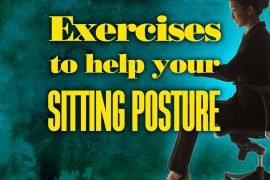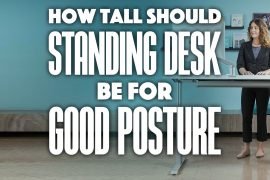[Updated on 1 April 2023]
Top 10 Ways To Fix Your Terrible Posture
Table of Contents
- Do Posture-Correcting Exercises
- Start with the basic do’s and don’ts for posture.
- Improve your posture with exercises from the Army Field Manual.
- Fix your posture with three exercises against a wall.
- Get into proper posture at your desk with two simple body adjustments.
- Improve your posture and build balance with a daily warm-up.
- A guide to stretches that help fix terrible posture problems.
- Fix your computer hunch and other posture problems in 30 seconds.
- **If you have serious posture issues or pain, you’ll want to consult a doctor.**
- Fix Your Workstation
- If you’re a desk jockey, you might get the most posture improvement from setting up your workstation properly.
- Figure out the ideal desk height, whether sitting or standing, and keep your feet flat on the floor when sitting (an easy way to find the right seat high is to level it with your knees).
- Here is Lifehackers complete guide to setting up an ergonomic workspace.
- Hold Your Phone and Tablet Properly
- Constantly craning your neck down to stare at our phones isn’t helping.
- Try holding your phone straight in front of you instead of bending your head down.
- Try propping your tablet up perpendicular to the table if you’re just reading.
- Use Apps to Improve Your Posture
- Nekoze is a cute app that uses your Mac’s camera to keep an eye on your posture—a cat (icon) will warn you when you’re slouching.
- There are other posture trainers for iOS and Android.
- If you’re not into apps using your camera, build your own posture sensor for your chair.
- Learn to Breathe Properly
- How we breathe can deeply affect how we move and how we feel.
- Learn to breathe more effectively, using your diaphragm.
- Try breathing exercises that focus on lengthening your spine and engaging your waist muscles and lower core muscles.
- Adjust Your Posture in Every Situation
- Sit up straight when driving.
- The type of pillow we use and the type of mattress we sleep on will affect how we hold ourselves during the day.
- Adjust the height of your counters in your kitchen to keep from hunching over.
- Sit at a 135 Degree Angle
- Sitting at a 135-degree angle could put less strain on your spine.
- Make sure you’ve got a good chair that supports your back and is ergonomic for your workspace.
- If you find it difficult to maintain sitting posture, consider using a posture correcting brace (A).
- Do Yoga or Work on Your Core Strength
- Exercises that strengthen your core will help you stand taller and help you maintain the proper posture.
- Emphasize body awareness and balance and you can work up to some pretty impressive poses.
- Pilates and any other exercises that focus on your core will help with your posture too.
- Test your back and neck posture against a wall
- Take a photo and compare to this illustration.
- Become more aware of your feet when you’re standing. Adjusting your weight evenly across both feet.
- Test your basic mobility and core strength.
- Get the balance board for the Wii Fit
- It’s well worth the price.
- Focuses on measuring your balance.
- It keeps you moving every day.
- Helps center posture with balancing strength and Flexibility (B).
- Helps change the brain to improve balance (C).
Top10 ways to fix terrible posture
Want to use this infographic on your site?
FAQs
Q1. What is poor posture, and what are its causes?
Poor posture refers to the way you sit, stand, or walk in a way that puts stress on your body. Common causes of poor posture include spending too much time sitting, carrying heavy bags or backpacks, and not exercising enough.
Q2. How does poor posture affect your health?
Poor posture may lead to various health problems, like back pain, neck pain, headaches, and poor digestion. It can also affect your breathing, circulation, and energy levels.
Q3. Can yoga help improve your posture?
Yes, practicing yoga can help improve your posture by strengthening your core muscles, improving your flexibility, and increasing your body awareness.
Q4. How does exercise help improve your posture?
Exercise can help improve your posture by strengthening the muscles that support your spine, such as your core muscles, back muscles, and glutes. It can also improve your flexibility and mobility.
Q5. Is sitting for long periods of time bad for your posture?
Yes, sitting for a long time can be bad for your posture, as it can put stress on your back, neck, and shoulders. It’s essential to take breaks and stretch regularly.
Q6. What is the best sleeping position for improving posture?
Sleeping on your back with the supportive pillow under your neck and knees can help improve your posture while you sleep.
Q7. How can mindfulness and meditation help improve your posture?
Mindfulness and meditation can help improve your posture by increasing your body awareness and reducing muscle stress and tension.
Q8. Are there any exercises to avoid if you have poor posture?
Some exercises, such as heavy lifting or exercises that put more stress on your back, may be best to avoid if you have poor posture. It’s essential to consult with a doctor or physical therapist before start a new exercise program.
Q9. Can chiropractic care help improve your posture?
Yes, chiropractic care can help improve your posture by realigning your spine, reducing tension in your muscles, and improving your overall mobility.
Q10. How long does it take to see improvements in your posture?
It may take many weeks or even months to see improvements in your posture, depending on the severity of your posture issues and the strategies you use to correct them. Consistency is key, so it’s important to stick with your posture-improving habits over time.
Conclusion
In conclusion, poor posture can cause a range of health issues, including back and neck pain, headaches, and decreased mobility. However, there are many ways to address bad posture and improve your overall health and well-being. The top 10 ways to fix terrible posture include exercises, stretches, and lifestyle changes to help you develop better habits and properly align your body. You can make significant progress towards correcting your posture with consistent effort and dedication and enjoy the benefits of a healthier, pain-free body. Remember that posture is not just about appearance; it’s about taking care of yourself and investing in your long-term health.









1 Comment
Bad or terrible posture can lead to aches and pains in the back, neck, and shoulders. Headaches and tension in the shoulders and back are often created by chronic bad posture.